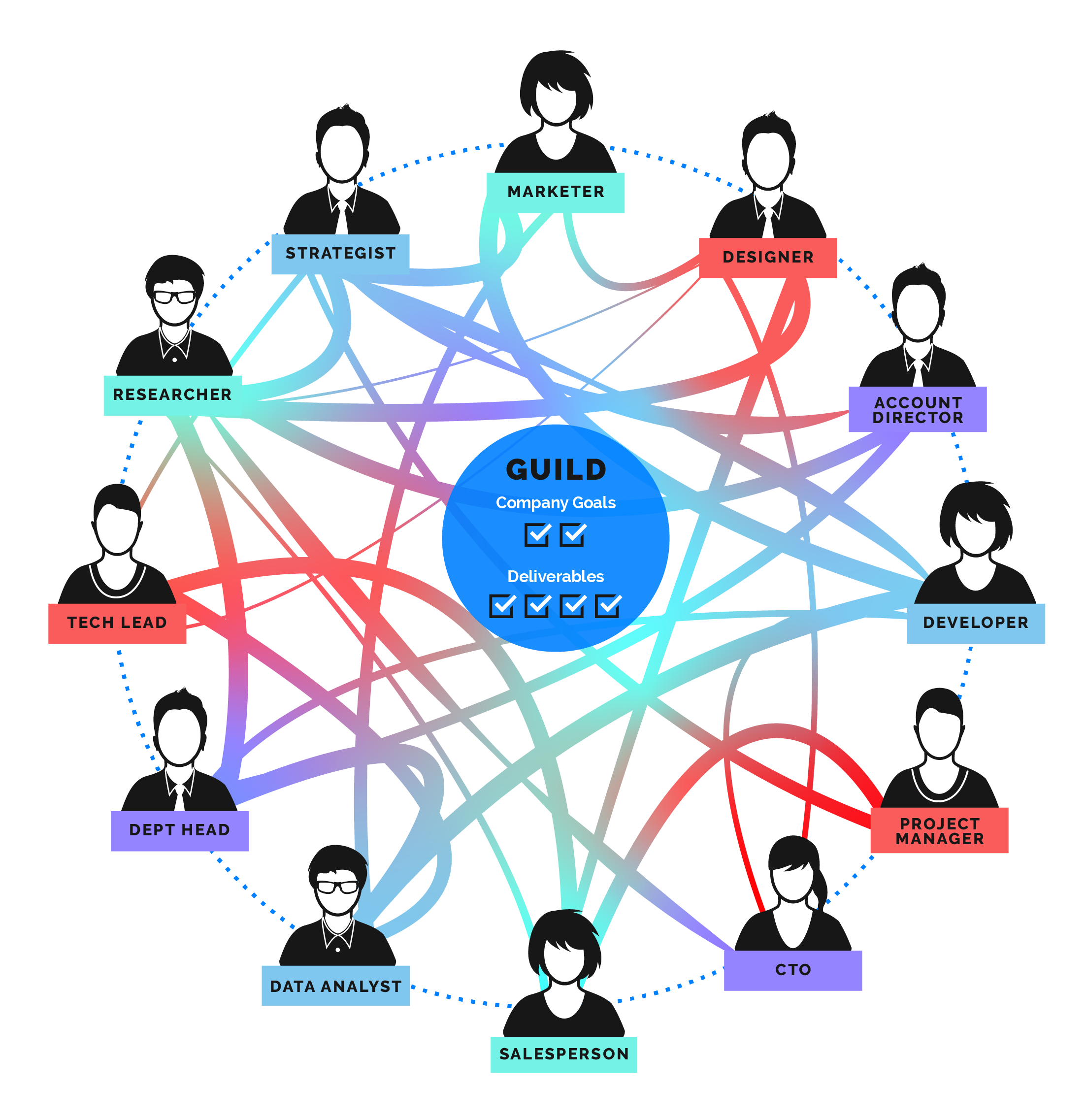Phase2 Guilds
Phase2 Guilds
Frank Febbraro | CTO
February 19, 2021
Transformational digital experience is a fast moving target. With an amazing roster of clients to serve, innovation activities can sometimes take a back seat.
Phase2 has come to realize that many of our major innovations wind up coming from cross-disciplinary teams. This makes sense as digital experience is not simply coding or installing a piece of technology, but a concert of user experience, branding, design, data insights, AND technology working together. This is where Phase2 guilds are most influential.
What is a Guild?
Guilds at Phase2, inspired by Spotify’s agile culture, help us organize, align, and focus our innovation activities and efforts.
A guild is a group of people with an owner that is accountable to a sponsor for an articulated deliverable, related to a stated focus.
Through a good deal of trial and error we have boiled the requirements of our guilds down to 5 simple things. To be a guild, the group must have:
- Team members interested in the mission
- A focus area
- An owner
- A sponsor and/or additional stakeholders
- One or more deliverables
Guilds should also be aligned with one or more of our company goals. At the end of the day, if these guilds are not driving toward something we aspire to do or be as a company, they are distracting us and wasting time.
Guild Formation
Guilds have sprung from two sources, much like other Innovations at Phase2, as grassroots and directed endeavors. Grassroots guild formation comes from our teams recognizing an opportunity to experiment, define, or formalize a capability of interest. Directed guilds have been formed when our Leadership or Innovation teams identify a need to move into a certain space or address areas of improvement in our offerings. Guilds provide enough structure around team formation to help facilitate progress toward objectives without getting bogged down by overhead. Guilds are opportunistic with about 80% of our guilds coming from grassroots efforts.

Guilds are dynamic and we encourage them to change/evolve. Over time, we have discovered a few different patterns of guilds. These patterns can be short or long lived, and the dynamic nature of guilds means they may transition from one form to another across time.
Guild Patterns
Several different patterns of guilds have emerged to keep us moving forward. Each uniquely helps us progress as an agency.
Taskforce
A Guild Taskforce is used when a quick hit goal (think < 90 days) is needed. Often this guild will dissolve when it has accomplished its goal or morph into a different type of guild. In recent years, we set up a Headless CMS taskforce that catalogued all the headless CMSs in the market at the time, performed Innovation Radar Assessments on each, and had lively presentations and discussion about the options. Since the goal of this taskforce was to get a “lay of the land” the Headless CMS Taskforce dissolved and reformed into the current JAM Stack Guild.
Product
The Product Guild is organized around a product or a suite of products. It works to expand product use, innovate how a product is used, or define standards of use/approach. One guild of this type to note is the Particle Guild, centered around the development and application of one of our design system tools, Particle and how we do frontend engineering at Phase2.
Another Product Guild is our Salesforce Guild. This guild originally started as an Innovation Guild (more on those later) and developed into a Product Guild. The goals of this Product Guild are to help organize knowledge, training, and certification as well as discover and innovate new ways to use Salesforce.
Continuing Development Guild
A Continuing Development Guild is focused on developing the skills of its participants. The members will often have study group meetings and wide-ranging discussions. They also support project teams that are working in the guild's area of focus. These guilds are often focused on skill sets that we already possess, but that we need to keep fresh or deepen, due to new feature releases or the training needs of new employees. A couple of examples of Continuing Development Guilds are our Javascript and Drupal Guilds.
Innovation Guild
An Innovation Guild’s purpose is to enable sales, marketing, and practitioner efforts around a brand new capability. This is accomplished through a mixture of discussion, research, and experimentation.
While an Innovation Guild begins with a group of core members to lay a foundation, as a capability matures, the guild will open up to other interested members. Eventually we expect a guild of this kind to transition to a full fledged practice or develop one of the other types of guilds mentioned above.
As mentioned, our Salesforce Guild started as an Innovation Guild to define our point of view and approach to Salesforce development and later transitioned to a Product Guild. We have also started Innovation Guilds around native application development, Customer Data Platforms (CDPs), and AI and Machine Learning.
At Phase2, guilds have made a meaningful difference in how we do our work. Many of the best ideas for solution approach and innovation investments, have come from our guilds. We are always looking for the next great thing and the only limit is the time and attention we can marshal toward these efforts. Guilds are one of the various ways we guide our clients toward what’s next in the digital landscape and continue to enrich the work lives and skills of our talented teams.
Thank you for reading! Do you have your own observations or ideas about this topic? Please reach out via LinkedIn or Twitter. Subscribe below for regular news and insights.


